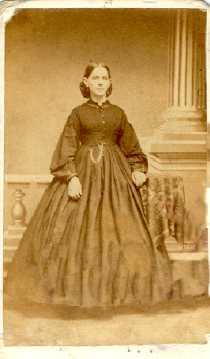
Dating a CDV is a multi-step process. This type of photograph became available in 1858, and existed in different formats throughout the 1860s and 1870s. The shape, style and color of these small cards changed as the decade progressed.
Even the style of the portrait can help pinpoint a date. William C. Darrah’s book, Cartes de visite in 19th Century Photography (self-published), presents identification information and multiple examples. This portrait is on thin white paper with square corners. Square-cornered images on plain white paper were commonly used between 1858 and 1866. However, the painted backdrop became fashionable in 1861. Photographers used theatrically painted backdrops and props to add visual interest to portraits.
The woman’s costume is interesting. Her dress is typical of the early 1860s, with bishop sleeves gathered at the wrists and a full hoop skirt. Her accessories of dangling earrings, a small brooch and a watch at the waist were standard for a woman who cared about her appearance. Watches could be worn around the neck or draped at the waist from a belt. It’s difficult to see the belt in this image, but the way she’s wearing the watch confirms that she’s wearing at least a thin belt of the same color as her dress.
The most telling piece of her costume is her collar. Throughout the 1860s, women’s collars were white to contrast with the dress. This woman, however, is wearing a dark collar, signifying mourning. She’s a recent widow or has lost another family member. Full mourning costume included all-black accessories, such as a hat and veil. The lack of these formal mourning accessories may indicate her personality or that the death occurred several months before.
Another way to identify Civil War-era photographs is the presence of a revenue stamp. From Sept. 1, 1864 to Aug. 1, 1866, the United States levied a tax on photographs. Each image sold during those years has something resembling a postage stamp on the back. This photograph does not have a revenue stamp, indicating it was taken prior to 1864.
Adding together all the clues in this simple image, it is likely this photograph was taken between 1861 and 1864. Pat Morrison believes this woman is her father’s great-grandmother. Since her father was born in 1910, it’s quite possible this is the case. Pat now needs to re-examine her genealogy to see who was in mourning when this photograph was taken.




